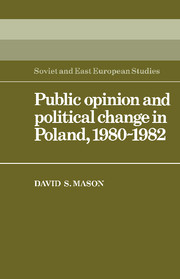Book contents
- Frontmatter
- Contents
- List of tables
- Preface
- Introduction: public opinion and politics
- 1 Public opinion research in Poland
- 2 The public and policy change in the 1970s
- 3 Values of Polish society on the eve of August
- 4 1980: causes and results
- 5 The rise and fall of Solidarity
- 6 The Party and ‘renewal’
- 7 Solidarity and the regime at the end of 1981
- 8 Martial law as a response and the response to martial law
- 9 Conclusions
- Appendix
- References
- Index
6 - The Party and ‘renewal’
Published online by Cambridge University Press: 05 February 2012
- Frontmatter
- Contents
- List of tables
- Preface
- Introduction: public opinion and politics
- 1 Public opinion research in Poland
- 2 The public and policy change in the 1970s
- 3 Values of Polish society on the eve of August
- 4 1980: causes and results
- 5 The rise and fall of Solidarity
- 6 The Party and ‘renewal’
- 7 Solidarity and the regime at the end of 1981
- 8 Martial law as a response and the response to martial law
- 9 Conclusions
- Appendix
- References
- Index
Summary
The Polish United Workers' Party (PZPR) is ‘the leading political force in society’ according to the country's Constitution. The Party Statutes adopted in 1959 defined the Party as ‘the vanguard of the working class, the highest form of its organization, the guiding force of the socialist revolution’. Yet by 1980, the Party had virtually collapsed as an institution representative of the interests of the workers. The weakness of the Party was at least partly responsible for both the development of Solidarity in the summer of 1980 and for the imposition of martial law in December of 1981. The lack of trust in the Party and its authoritarian and unrepresentative character led the workers to demand an institution more responsive to their own needs. But the growth of Solidarity during 1981, and the continuing disintegration and fragmentation of the Party led the military to preempt the Party's leading role in 1982.
The collapse of the Party in 1980 and 1981 was due to a number of factors. The Party leadership bore the burden of the economic failures of the late 1970s and the consequent decline in the standard of living. The Party itself had grown rapidly in size during that period, though the influence of ordinary Party members and local Party organizations declined in the face of increasing centralizing tendencies in the latter half of the decade. This led to problems of morale even within the Party, and the growth of horizontal barriers between the mass Party membership and its leadership.
- Type
- Chapter
- Information
- Public Opinion and Political Change in Poland, 1980–1982 , pp. 138 - 163Publisher: Cambridge University PressPrint publication year: 1985



